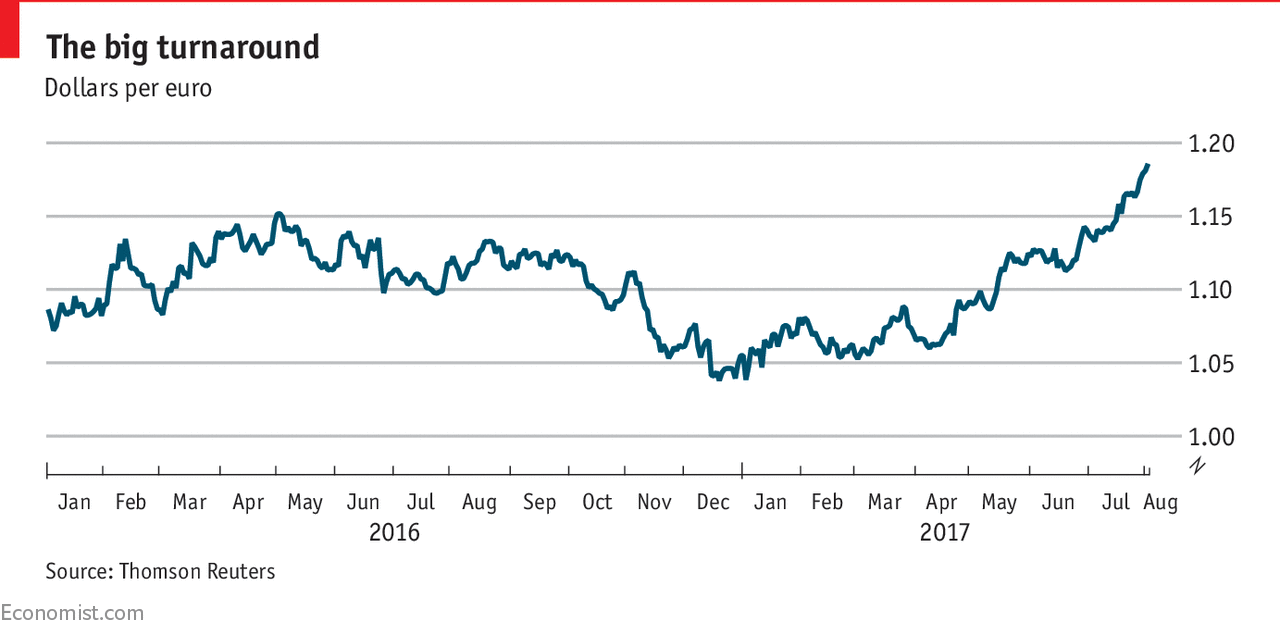THE DOW Jones Industrial Average closed above 22,000 on August 2nd, something President Trump is almost certain to mention in a tweet soon*. So it might seem as if the “Trump bump”, which began on the night of the election, is continuing smoothly. But the picture is a lot more complex than that as a look at the euro/dollar rate shows (see chart). The euro fell (and the dollar rose) between election day and the end of 2016. But then came a turning point. The euro has been climbing (and the dollar retreating) for much of 2017.
For dollar-based investors, that means European shares have been a much better bet this year. As of august 2nd, euro zone shares (as measured by the FTSE Euro 100) were up 19.9% since the start of the year, while the S&P 500 was up10.7%. Looked at another way, the American market has dropped by 8% in euro terms since February 2nd.
-
A tale of two markets
-
Retail sales, producer prices, wages and exchange rates
-
Foreign reserves
-
The unintended effects of rules aimed at stopping financial crimes
-
The Department of Justice wants to end race-conscious university admissions
-
Attitudes towards the mainstream media take an unconstitutional turn

It is a similar story to the UK market after Brexit; the FTSE 100 index jumped in sterling terms, but in dollar terms it was down because of the pound’s decline. The two markets interact. A falling currency is good for a country’s exporters and for its multinationals (whose overseas earnings are worth more in domestic currency terms). That explains some of the resilience of the FTSE 100 and the Dow and some of the recent weakness in European equities; the German Dax is 6% off its June high.
At the micro level, we have also seen a shift in the markets. In the initial aftermath of the election, the big gainers were American stocks with high tax rates or those exposed to infrastructure spending; they were seen as benefiting from a fiscal stimulus. But no detailed plan for stimulus has yet been proposed in part because the administration devoted its energy to repealing Obamacare; those stocks have lost the ground they made. Instead the big winner of the first half was the tech sector, which has not always been a favourite of the new President. Earnings generally have been strong and forecast revisions are the best that has been seen in the last six years, according to Bank of America, with multinationals leading the way.
The failure to pass a stimulus has also weighed on the dollar. The hope was that a strong American economy would prompt Janet Yellen (pictured right) at the Federal Reserve to push interest rates up quickly. So far, America had a weak first quarter, followed by a better second quarter (but only in line with euro zone growth) – the IMF cut its growth forecast for America for 2017 and 2018 to 2.1%. That means Ms Yellen may proceed more slowly with monetary tightening and may be replaced by a Trump loyalist next year; that means there is less reason to buy the greenback. The euro zone in contrast has enjoyed a pick-up in growth and the European Central Bank will be cutting back on its easing of policy. The EU has also seen off the populist threat of Marine Le Pen on France and Angela Merkel looks set for re-election. That creates more reasons to buy the euro. But the year might not have seen its last twist with the possibility for America to escalate its trade dispute with China and its political pressure on North Korea, each of which might lead to risk aversion. That could push the dollar back up and equities down.
*An odd measure of success for him to pick. The American market returned 235% under Obama, his immediate predecessor; that will be hard to top.
Source: economist
A tale of two markets